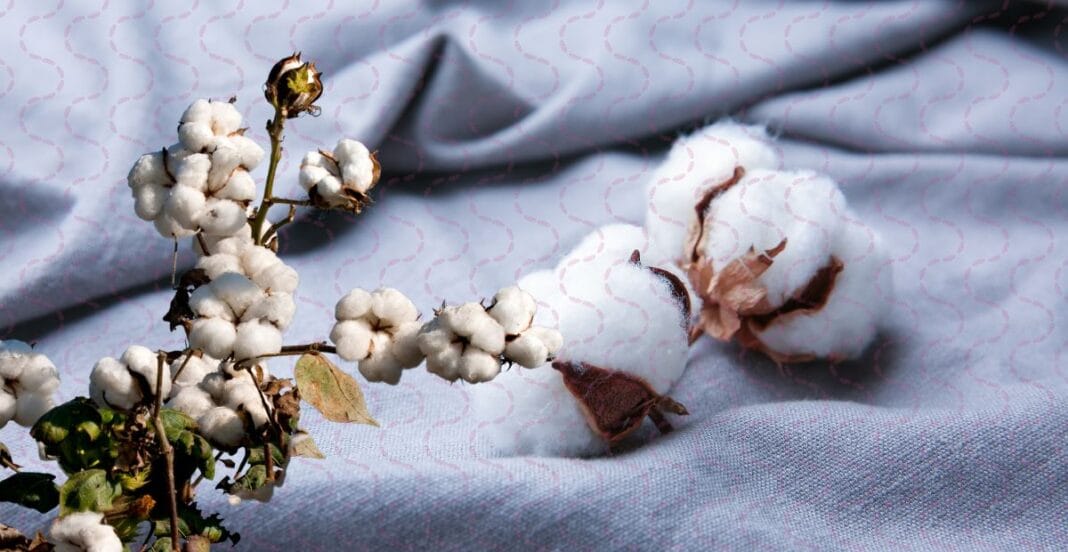Cotton fiber holds the position of being one of the most beloved materials throughout the world. It stands out as soft and strong while remaining entirely natural and has been integral to human existence since ancient times. This fiber provides unmatched comfort and breathability while delivering exceptional style for both clothing and home goods.
This ultimate guide will teach you all there is to know about cotton fiber. This guide will cover cotton fiber’s history and features alongside its applications and reasons why it remains the preferred textile material.
Let’s dive right in!
Table of contents
What are Cotton Fibers?
The soft cotton fibers grow from the fluffy area of the cotton plant. The cotton plant produces soft material that encloses its seeds for protection. The process people use to separate the cotton fibers from the seeds after harvesting is known as ginning.
This process creates a pure and white fiber that manufacturers can turn into thread or fabric. The natural properties of cotton fiber give it a soft touch while allowing easy dyeing and ensuring durability for many years.
A Brief History of Cotton Fibers
The history of cotton fibers extend over many centuries. More than 5,000 years back, people from ancient India, Egypt, and China performed spinning and weaving of cotton fiber. It reached Europe through traders who expanded its reach beyond the continent.
The Industrial Revolution introduced machines that dramatically increased cotton production. It became available to all people while previously it was exclusive to wealthy individuals. The worldwide cultivation and utilization of cotton fiber continues in modern times.
How Cotton Fiber Is Grown
Cotton plants are predominantly cultivated by farmers in warm climate regions. Cotton plants require sunlight and water together with proper care to grow successfully. The cotton fiber matures five to six months after planting the seeds.
Farmers collect cotton bolls after they open. Machines perform the separation of fiber from seeds after harvesting. The cotton fiber undergoes cleaning followed by spinning into yarn before it becomes ready for use.
Key Properties of Cotton Fiber
The popularity of cotton fiber comes from its numerous exceptional characteristics. Let’s explore them:
- These fibers provides a gentle texture when it comes into contact with the skin.
- Breathability makes it excellent because it allows air to flow through freely to keep you cool.
- It remains strong and resilient even after extensive washing and wearing throughout multiple years.
- It absorbs moisture rapidly which makes it perfect for towels and clothing items.
- Since it is a natural material, it decomposes easily providing environmental benefits.
The numerous benefits of these fibers explain its worldwide popularity.
Different Types of Cotton Fibers
Not all cotton fibers are the same. Here are the main types:
1. Upland Cotton
The most frequently used cotton fiber type is Upland cotton. This fiber provides strength at a reasonable price and suits daily wear clothing.
2. Egyptian Cotton
Egyptian cotton stands out because of its exceptionally long fibers which provide a soft and luxurious feel. Manufacturers typically select Egyptian cotton for their premium sheets and towels.
3. Pima Cotton
Pima cotton fiber shares similar characteristics with Egyptian cotton. The Pima cotton fiber provides durable strength alongside soft comfort and superior color retention.
4.The organic Cotton
Organic cotton fiber grows without harmful chemicals. Organic cotton fiber benefits both nature by avoiding harmful chemicals and sensitive skin by reducing irritation.
Different cotton fiber types possess unique characteristics which meet specific requirements. Here you can read about different types of cotton fabrics in detail.
How Cotton Fiber Is Used Today
These fibers are everywhere! You find it in:
- T-shirts, jeans, and dresses
- Towels and bedsheets
- Medical supplies like bandages
- Home décor items like curtains and cushions
Cotton fiber mixes with different fibers to produce flexible fabric for multiple applications.
Cotton fiber stands out as an excellent choice for sustainable fashion because its organic production lowers environmental impact and it consumes less energy than synthetic fibers.
Today, people care more about eco-friendly choices. Cotton fiber plays a big role here. Cotton fiber grown organically and responsibly minimizes its effect on the environment.
The production of cotton fiber requires less energy compared to synthetic fibers. Plus, cotton fiber is biodegradable. This material goes back to nature without any harmful effects when disposed of correctly.
Selecting cotton fiber materials promotes sustainable fashion practices which benefit our environment.
Tips to Care for Cotton Fibers Products
Follow these simple tips to extend the life of your cotton fibers items:
- Wash with cold or lukewarm water.
- Use mild detergents.
- Avoid over-drying in the machine.
- Keep cotton clothing in a space that remains cool and dry.
Appropriate maintenance ensures cotton fibers remain soft and retain their fresh appearance over extended periods.
Fun Facts About Cotton / lint Fibers
Here are some quick, fun facts:
- One cotton boll contains about 250,000 fibers!
- When cotton fibers absorbs moisture, it stretches to 30% beyond its original length.
- China, India, and the United States rank first as the leading producers of cotton.
- Around 40% of all clothing materials around the world use cotton fibers.
Isn’t that amazing?
Conclusion
Nature created cotton as its most flexible and gentle gift to humankind. Ancient periods to modern fashion demonstrate cotton’s enduring significance. The combination of softness and breathability with eco-friendly characteristics renders it a timeless option.
With your newfound knowledge of cotton fiber, you will develop a deeper appreciation for the cotton products you own.
FAQs
The seed hairs of the cotton plant produce cotton fiber. The primary component of cotton fiber is cellulose which naturally provides strength and softness while allowing flexibility.
Cotton fibers are soft, breathable, and absorbent. The fiber maintains your body’s cool temperature in hot conditions while providing comfortable skin contact which makes it ideal for clothing.
Cotton fibers demonstrates eco-friendliness through sustainable growing practices. Cotton fibers decomposes naturally and comes from renewable sources while requiring less chemical use than synthetic fibers.



I really appreciate how you highlighted the natural elegance of cotton. It made me think about how different varieties, like Egyptian or Pima cotton, compare in terms of softness and durability. Would love to see a future post that explores that!